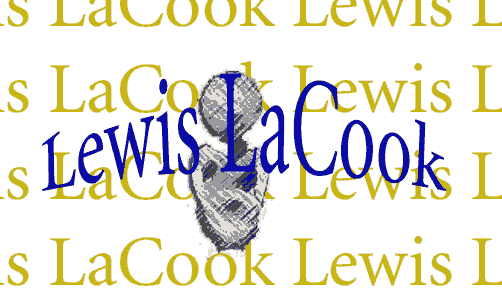
 |
BIOLewis LaCook is a poet who wandered one day into a gorgeously chaotic, polylogical room. He's been there ever since. Born in Lorain, Ohio on November 5, 1970, he began writing poetry in his early teens, shortly after the death of his father. At sixteen, Black River Review first published his work; subsequently, small press journals like Whiskey Island, the Coventry Reader, and Lost and Found Times published LaCook's poetry. While attending Kent State University in the mid-to-late nineties, LaCook developed a passion for music, and played in several bands. Chad Mossholder of the ambient techno duo Twine was an early band mate. During this time LaCook continued to write poetry and publish in the small presses, culminating in 2000 when anabasis press published his long poem Cling as a chapbook. In the late nineties LaCook discovered the internet, and was immediately struck by how easily he might combine his two passions, music and poetry, into a cohesive whole. After the unexpected and tragic death of a close friend in 1999, LaCook barricaded himself in an apartment in Kent, Ohio, and taught himself the rudiments of HTML. It was during this period that LaCook also began collaborating with the poet Sheila Murphy; their long poem, Beyond the Bother of Sunlight, has appeared in excerpts in several small press venues, but has yet to be published in its entirety. As LaCook's use of the internet increased, his focus began to shift from using the medium as a multimedia and distributive tool to exploring it for its own sake. In 2001 he left Kent State University to live with his fiancee Renee Vaverchak in Richmond, Virginia. While there, he began teaching himself basic programming skills, and began using Macromedia's Flash authoring tool to realize his vision of an interactive hypermedia poetry. His early works in this genre met with some success; Rhizome.org began accepting his works into their artBase in 2002, and online venues like CTheory Multimedia, Cauldron and Net, Artifacts at Web Del Sol, 3rd Bed and Slope presented his works on their web sites. LaCook continues to work in a networked medium, reveling in the ability it gives him to create work that allows for the collaboration between the user and the work itself. |
|
This piece is a homage to the real life Alan Sondheim,
writer, philosopher and networker, who has inspired so many of us over
the years. Alan Sondheim is a piece of artware--a downloadable text editor that continually frustrates the expressive intents of the user. Alan Sondheim will scramble and fray any text that is typed into it.
|
ARTIST'S STATEMENTI've found over the years that, when it comes to exploring a networked medium, there are two ideas that fascinate me, and that are inherent in the mechanism of internet art. The first is the aleatoric process, or chance operations. Every piece of net art I create is based at least somewhat on this principle. The idea of a "stable" artwork in a networked environment, an artwork that never changes, that looks and behaves exactly the same for every user that encounters it, interests me not in the least. No matter how beautiful or brilliant such a work is, it's not taking advantage of its own materiality or environment, and can just as easily appear in another format, such as a book, a gallery space, or a cinema screen. The computer works via variables and loops, and variables, well, VARY. My obsession with this concept takes the form of using the machine's native ability to generate pseudo-random numbers, and to make decisions based on those numbers. Thus, when I create a networked piece, it neither looks the same for every user nor reads the same for every user. While some elements in any given work of mine do remain stable, some elements will always vary. Sometimes the text itself is generated this way (there are SEVERAL methods for accomplishing this), sometimes the music, and sometimes the graphic elements. While these chance elements are limited by the number of parameters I set for variance (in any given work, there are a finite set of possible ways the piece will vary; creating an infinite variability is unfortunately impossible), I do believe it's a step in the right direction. The second concept, related somewhat to the first, is the idea of a user collaborating with a work, as opposed to passively viewing it. A user's collaboration may take the form of simply opening the piece (whereby some of the afore-mentioned aleatoric processes may become a factor), or by having a direct hand in the work's manifestation. To me, this is the very essence of a NETWORKED work of art: that it participate, in an active way, with the network of people viewing the work. This is also what, for me, distinguishes net art from more traditional media. These two concepts enrich and inform my work--and, thereby, enrich and inform me. |